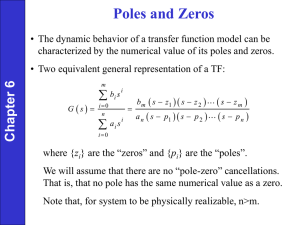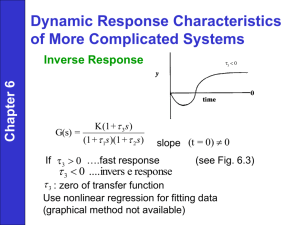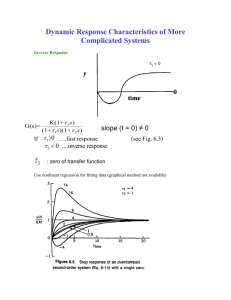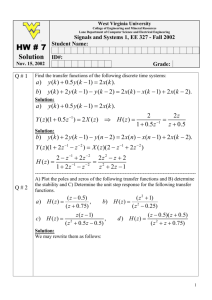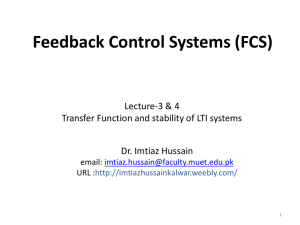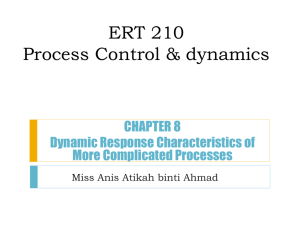Document
advertisement
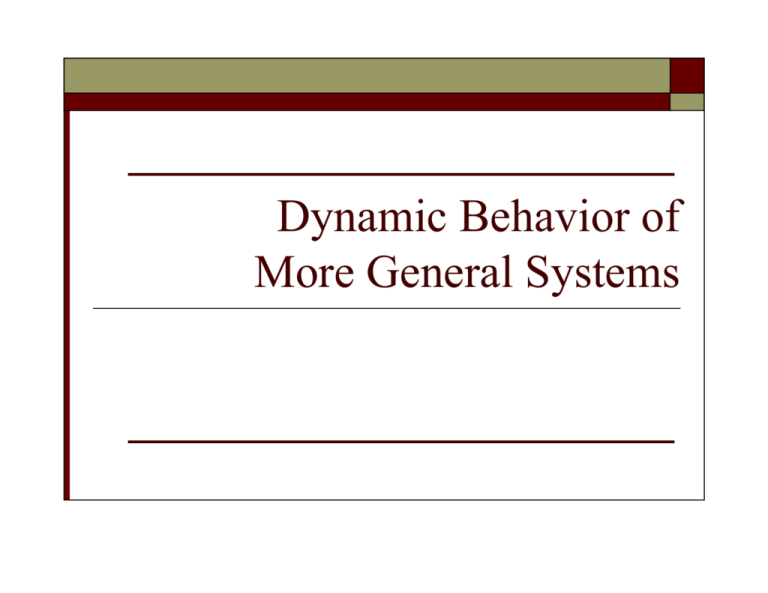
Dynamic Behavior of More General Systems Poles and Zeros • The dynamic behavior of a system is characterized by the poles of its TF. Zeros of the TF modify the dynamic behavior. Consider two equivalent representations of a TF: m G s i b s i i 0 n ai s i b m s z 1 s z 2 s z m an s p1 s p 2 s p n i 0 where zi are the zeros and pi are the poles. We will assume no pole-zero cancelations and m ≤ n to have a physically realizable system. Poles Any scalar rational transfer function can be expanded into a partial fraction expansion, each term of which contains either a single real pole, a complex conjugate pair or multiple combinations with repeated poles. First Order Pole A general first order pole contributes K G s s 1 The response of this system to a unit step: Effects of Poles • Pole in right half plane (RHP) results in unstable system Im x p a bj x x Re • Complex pole: results in oscillatory responses Im x Re x • Pole at the origin (1/s term in TF model): results in an “integrating process” Effects of Poles: Summary Zeros The effect that zeros have on the response of a transfer function is more subtle than poles because they describe the combined effect from additive interactions among the responses associated with different poles. Example Find a step response of an overdamped 2nd order TF with a single zero: G s K a s 1 1s 1 2s 1 Solution: a 1 t / a 2 t / 1 2 y t KM 1 e e 2 1 1 2 • Note that y t KM •The dynamic modes are determines by poles. •A zero modifies the response because it determines the weighting of modes. Effect of the Zeros Location For the case of τ1>τ2 consider: Case a: a 1 Case b: 0 a 1 Case c: a 0 (RHP zero) Inverse Response is Due to Two Competing Effects An inverse response occurs if: K 2 2 K 1 1 Effects of Zeros • Zeros have no effect on system stability • Zero in RHP: results in an inverse response to a step change in the input • Zero in left half plane: may result in “overshoot” during a step response Time Delays 1. Transport delays 2. Measurement delay - Sampling line delay - Time required to do the analysis (e.g., on-line GC) for t 0 y t u t for t Implications for Control: Time delays are bad for control because they involve a delay of information Example: Turbulent flow in a pipe u fluid property (e.g., temperature or composition) at point 1 y fluid property at point 2 Fluid In Fluid Out Point 1 Point 2 TF of Time Delays Y s U s e s Rational Approximation of TD TF 1. Taylor Series Expansion: e s 1 s 2s 2 3s 3 4s 4 2! 3! 4! Usually truncating after only a few terms 2. Padé Approximations: Example: 1-1 Padé approximation is, e s 1 s 2 1 s 2 Interacting vs. Noninteracting Systems • Consider a process with several inputs and outputs. The process is interacting if: o Each input affects more than one output. or o A change in one output affects the other outputs. Otherwise, the process is noninteracting. A noninteracting system: two surge tanks in series. Two tanks in series whose liquid levels interact. (Skip) Noninteracting Example Mass Balance: dh1 A1 q i q1 dt Valve Relation: 1 q1 h1 R1 In deviation form: dh1 1 A1 q i h1 dt R1 1 q1 h1 R1 TF’s for Tank 1: H 1 s R1 K1 ; Q i s A1R1s 1 1s 1 Q1 s 1 1 H 1 s R1 K 1 For Tank 2: H 2 s R2 K2 ; Q 2 s A 2 R 2s 1 2s 1 Q 2 s 1 1 H 2 s R 2 K 2 or Q 2 s Q 2 s H 2 s Q1 s H 1 s Q i s H 2 s Q1 s H 1 s Q i s Q 2 s 1 K 2 1 K1 1 Q i s K 2 2s 1 K 1 1s 1 1s 1 2s 1 Does unity gain make physical sense ? Input-output model for two liquid surge tanks in series. Model of an Interacting System 1 q1 h1 h2 R1 H 2 s R2 2 2 ; Q i s s 2 s 1 Q 2 s 1 2 2 ; Q i s s 2 s 1 H 1 s K 1 a s 1 2 2 Q i s s 2 s 1 where 1 2 , 1 2 R 2 A1 R1R 2 A 2 / R1 R 2 , and τ a 2 1 2 Model Comparison Noninteracting system Q 2 s 1 Q i s 1s 1 2 s 1 A 1 R 1 and τ2 A2R 2 . Interacting system Q 2 s 1 2 2 Q i s s 2 s 1 where τ 1 where 1 and 1 2 General Conclusions 1. The interacting system has a slower response. (Example: consider the special case where = 2. Which two-tank system provides the best damping of inlet flow disturbances? Approximation of Higher-Order TF’s The transfer function for a time delay can be expressed as a Taylor series expansion. For small values of s, e 0s 1 0s e 0s 1 e 0s 1 1 0s Thus, time delays can also be used to approximate poles and zero of the transfer function Skogestad’s “half rule” • An approximation method for higher-order models that contain multiple time constants • The largest neglected time constant is approximated by: •One half of its value is added to the existing time delay (if any) and the other half is added to the smallest retained time constant. •Time constants that are smaller than the “largest neglected time constant” are approximated as 1 1 0s e 0s Example G s K 0.1s 1 5s 1 3s 1 0.5s 1 Derive an approximate first-order-plus-time-delay model, s Ke G s s 1 using two methods: (a) The Taylor series expansions (b) Skogestad’s half rule 1 1 0s e 0s and 1 0s e 0s Compare the normalized responses of G(s) and the approximate models for a unit step input. Solution (a) The dominant time constant (5) is retained. Approximate other poles and zeros as 0.1s 1 e 0.1s and 1 e 3s 3s 1 1 e 0.5s 0.5s 1 Then GTS Ke 0.1s e 3s e 0.5s Ke 3.6s s 5s 1 5s 1 (b) To use Skogestad’s method, we note that the largest neglected time constant in =3 • According to the “half rule”, half of the largest neglected time constant value is added to the next largest retained time constant to generate a new time constant 5 0.5(3) 6.5 • The other half provides a new time delay of 0.5(3) = 1.5. • The approximation of the RHP zero provides an additional time delay of 0.1. • Approximating the smallest time constant of 0.5 in produces an additional time delay of 0.5. • Thus the total time delay in the approximating TF is: 1.5 0.1 0.5 2.1 • The overall result is: G Sk Ke 2.1s s 6.5s 1 Comparison of step responses of the actual and two approximated models Skogestad’s method provides a somewhat better approximation Example 6.5 G s K 1 s e s 12s 1 3s 1 0.2s 1 0.05s 1 Use Skogestad’s method to derive two approximate models: (a) A first-order-plus-time-delay model (b) A second-order-plus-time-delay model in the form: s Ke G s 1s 1 2s 1 Compare the step responses for the result Solution (a) For the first-order-plus-time-delay model, the dominant time constant (12) is retained. • One-half of the largest neglected time constant (=3) is allocated to the retained time constant and one-half to the approximate time delay. • Also, the small time constants (0.2 and 0.05) and the zero (=1) are added to the original time delay. • Thus the model parameters in FOPTD model are: 3.0 1 0.2 0.05 1 3.75 2 3.0 13.5 12 2 (b) An analogous derivation for the second-order-plus-time-delay model gives: 0.2 1 0.05 1 2.15 2 1 12, 2 3 0.1 3.1 In this case, the half rule is applied to the third largest time constant (0.2). The normalized step responses of the original and approximate transfer functions are shown in Fig. 6.11. Multiple-Input, Multiple Output (MIMO) Processes • Most industrial process control applications involved a number of input (manipulated) that simultaneously affect multiple outputs • These applications often are referred to as multiple-input/ multiple-output (MIMO) systems to distinguish them from the simpler single-input/single-output (SISO) systems that have been emphasized so far • Modeling MIMO processes is conceptually similar to modeling of SISO processes • Level h in the stirred tank and the temperature T are to be controlled by adjusting the flow rates of the hot and cold streams wh and wc • Temperatures of inlet streams Th and Tc are potential disturbances • The outlet flow rate w is constant. Liquid properties are also assumed constant
